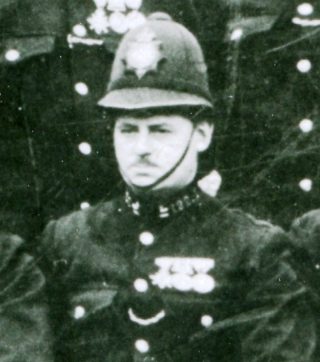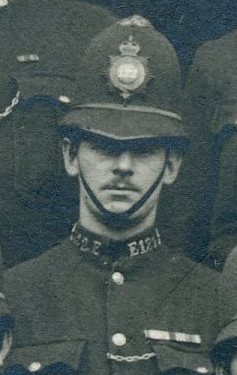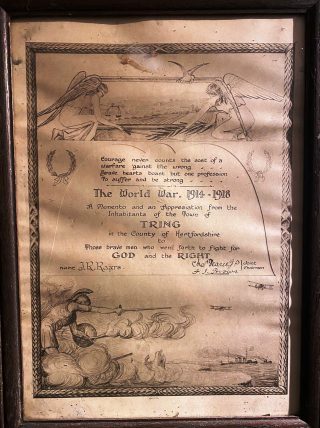
John Robert Rogers
Early Life.
John Robert Rogers, who was also known as Jack, was born on the 2nd June 1891 at Amersham.
His father, Harry Rogers married his mother, Annie Carter Wainwright, on the 7th April 1883 at St Pauls Church, Greenwich. They had six children who were George born in 1883 at Chesham, William born in 1886 at Chesham, Annie born in 1888 at Chesham, John, Frank born in 1894 at Tring and Harry born in 1900 at Tring.
During the 1891 census the family were living at Bury End, Amersham and Harry was employed as a groom.
In 1900 Harry Rogers died at Tring. In the 1901 census the family are shown as living at 24, Charles Street, Tring and John’s mother Annie, now a widow, is employed as a laundress. They are still at the same address during the 1911 census except for John who has joined the Royal Navy.
Early Naval Career.
His Naval Service Record has survived:
On the 4th May 1909 John signed up for a short service engagement of 5 years and 7 on the reserve as Stoker 108630 with Chatham as his Home Port. His details were recorded as follows; he stated he was born on the 2nd June 1890 (he appears to have made himself a year older) at Amersham, Bucks. He gave his occupation as being a labourer and his religion as Church of England.
Physically he was 5 feet 10 inches tall, with a 37 ½ inches chest, with dark brown hair, hazel eyes and a dark complexion. As an identifying mark he had a scar on his left big toe.
He Served On The Following Ships.
From the 4th May to the 23rd September 1909 he served on HMS Acheron. Based at the Nore, HMS Northumberland was a Minotaur class ironclad battleship launched in 1866. She became a depot ship in 1898 and was renamed HMS Acheron on becoming a training ship for Stokers in 1904. John was a Stoker 2nd Class.
From the 24th September 1909 to the 4th August 1910 he was aboard HMS Jason a torpedo gunboat launched in 1892 and converted to a minesweeper in 1909. (She was sunk by a naval mine in 1914). Whilst aboard Jason John was promoted to Stoker. On the 31st December 1909 his character and ability were assessed as being very good.
From the 5th August 1910 to the 24th July 1911 he was back on HMS Acheron. On the 31st December 1910 his character and ability were again assessed as being very good.
From the 25th July 1911 to the 7th August 1911 he served at HMS Pembroke II which was an Accounting Base at Chatham which included barracks. Then from 8th August 1911 to the 31st May 1912 he was aboard HMS St George a first class cruiser of the Edgar class, which was launched in 1892 and scrapped in 1920. On the 31st December 1911 his character and ability were assessed as very good and satisfactory.
From the 1st June 1912 to the 12th May 1914 he returned to HMS Pembroke II. On the 31st December 1912 and the following year his character and ability were once again assessed as being very good and satisfactory on both occasions.
On the 3rd May 1914 he transferred to the Class B, Royal Fleet Reserve at Chatham. The Royal Fleet Reserve was established under the authority of “The Naval Reserve Act, 1900,” and of “The Naval Forces Act, 1903,” to provide a reserve of trained men for service in His Majesty’s Fleet in time of emergency. Class B Reservists receive a retainer of 6d. a day, and a gratuity of £50 when they are 40 years of age and have completed 20 years’ service in the Fleet and Royal Fleet Reserve combined. Men belonging to Classes A. and B. are required to perform one week’s drill at their Home Ports each year.
John then applied to and was accepted to join the Hertford County Constabulary.
Police Service.
John’s Form 3 Police Service Record has survived and reveals the following information: It shows he was born on 2nd June 1891 at Amersham, Bucks., his height was 5 feet 10 inches, his chest 37 inches, his complexion was dark, his eyes hazel and his hair dark brown. He gave his previous occupation as serving aboard HMS Spey as a Royal Navy Stoker. HMS Spey is not listed in his Naval Service Record, but it was a Medina class iron screw gunboat launched in 1876 and sold in 1923. He also stated that he could ride a bicycle and that he could swim.
John attended a medical examination on the 3rd July 1914 which would have been at Police Headquarters, Hatfield. He must have been certified as fit to serve as a constable as he was appointed on the 22nd July 1914 and started his training at Headquarters.
He is believed to have commenced his training with PC’s William Henry Wightman, Henry Thomas Farrer, Frederick Hagger, Henry Owen, Leonard Howard and William Henry Williams. All seven are listed on General Order 118 of 21st July 1915 as being stationed in R Division and having been recalled to their military units. None had been issued with a warrant number indicating that they were all new recruits. The Service Records for Hagger and Howard have also survived, and like John Rogers’ shows their appointment dates as 22nd July 1914 making a strong case for Wightman, Farrer, Owen and Williams to have joined at the same time.
General Order 118 of 21st July 1915 is a list of 96 officers which included the Chief Constable, 43 Constables who were Army reservists who were recalled and 50 Constables and 2 Sergeants who volunteered for military service. John is shown as PC with no number Rogers J.R. R Division recalled to the Royal Navy on 2nd August 1914.
Royal Navy Service During The War.
From the 2nd August 1914 to the 20th February1915 he served on HMS Mars. She was a Majestic-class battleship, launched in 1896. She served as a guardship and transport in World War I and was sold in 1921. On the 31st December 1914 his character and ability were assessed as very good and satisfactory.
Marriage.
On the 28th January 1915 John married Mabel Georgina Matilda Blake at Camden Church, Camberwell. They both gave their address as 37, Jocelyn Street, Camberwell (her family home) and John is described as a Stoker in the Royal Navy. They had two children; Raymond John born in 1917 at Camberwell (in the 1939 Register he is shown as Hertfordshire PC living at Rickmansworth), and Kenneth Norman born in 1918 Camberwell (he is also shown in the 1939 Register as a Hertfordshire PC living at Watford).
From the 15th May 1915 to the 30th June 1916 he served aboard HMS Woolwich (HMS Botha). Woolwich was a depot ship for a Destroyer Flotilla, and effectively it would be used as a floating barracks. H.M.S. Botha was a sea going ship and was one of four flotilla leaders of the Faulknor class. At the end of 1915 his character and ability assessed as very good and satisfactory respectively.
Between the 1st July 1916 and the 2nd May 1917, he served on HMS Greenwich (HMS Botha). Greenwich was a depot ship for a Destroyer Flotilla and would have served the same purpose as HMS Woolwich. During this period, he was promoted to Leading Stoker and at the end of 1916 his character and ability were assessed as very good and satisfactory.
From the 3rd May 1917 until the 30th November 1918 he served aboard HMS Attentive II (HMS Botha). Attentive was based at Dover as the parent ship for destroyers and again would have been a floating barracks.
In Action.
During the night of the 20th/21st March 1918 nine German destroyers, six large torpedo boats and four small A-class torpedo boats of the Flanders Flotilla sailed to attack the coast between Dunkirk and Nieuport. British monitor HMS Terror opened fire and destroyers HMS Botha and HMS Morris and the French Capitaine Mehl, Bouclier and Magon sailed from Dunkirk. In the confused night action that followed Botha opened fire, rammed and sank German torpedo boat A-19, but was then mistaken for a German ship and torpedoed by the Capitaine Mehl. The Frenchman then in company with sister ship Bouclier sank the German A-7 with gunfire and torpedoes. Botha was damaged but not sunk.
Between the 1st December 1918 and the 12th February 1919, he again served on HMS Woolwich (HMS Botha). At the end of December 1918 and on the 12th February 1919 his character and ability were assessed on both occasions as being very good and satisfactory respectively.
He was discharged from the Navy on the 29th January 1919 but would undoubtedly have been on leave before that. He was later awarded the 1914-15 Star, the Victory and British War medals.
Re-joining The Police.
John was medically re-examined on 22nd January 1919 to ensure he was fit enough still to carry out Police duties. He obviously was as he was re-appointed on the 30th January 1919 and resumed his Probationer training at Police Headquarters.
General Order 93 of 13th April 1919 announced the postings of eight recruit Constables who were being brought on the Roster for duty and were being transferred from Headquarters to Divisions. Police Constable 122 J.R. Rogers was posted to E Division at Hitchin from the 11th April 1919. Each officer had to be Attested and the Superintendents concerned had to report to the Chief Constable when this had been done showing date and place of Attestation and before whom taken. John was Attested on the 12th April 1919 at Hatfield.
The Electoral Rolls of 1919 to 1926 list John and Mabel as living at 46, Tilehouse Street, Hitchin.
General Order 155 of 11th July 1919 informed John that he would receive an increased rate of pay from £2/3/0 to £2/7/0 per week from 10th April 1919.
Hertfordshire Detachment To Luton Re Riots.
John was part of a detachment sent to Luton to help quell rioting between the 20th July and the 5th August 1919.
General Order 177 of the 9th August 1919 announced that the following extract from a letter received from the Head Constable of the Luton Borough Police under date 4th August 1919 was published for information.
“I desire to express to you my high appreciation of the members of your Force on detached duty here for the riot. They proved to be excellent fellows in every way, gave a splendid account of themselves when need arose and conducted themselves in a manner which was credit to any Police Force.”
The Chief Constable is very gratified to have such a good account of the services of the detachment and congratulates Inspector Wright and the Sergeants and Constables. An entry of service on Riot Duty will be made in each man’s record sheet.

John Robert Rogers 1919 Luton Riot Duty
To see the whole photograph go to the Mutual Aid category and the article Hertford County Constabulary Assist With Quelling Rioters.
General Order 182 of 20th August 1919 informed John that he would receive an increased rate of pay from £3/18/0 to £4/0/0 per week from 22nd July 1919.
On the 6th November 1919 he passed his Ambulance certificate, an important qualification which entitled him to wear a badge on his lower left tunic sleeve to show he was trained in basic First Aid.
A Minor Blemish.
General Order 231 of 30th November 1919 revealed that John had been disciplined for something he had failed to do at 3.40 a.m. on Friday 21st November 1919, the exact circumstances were not explained. The Chief Constable suspended him from duty pending the case being heard, which in effect was for one day from the 26th to 27th November and fined him £1. In the overall schedule of punishments available to the Chief Constable this was very low down in severity.
The following Orders informed John that he would be receiving an increase in his weekly pay:
General Order 131 of 31st July 1921 from £4/2/0 to £4/4/0 from 22nd July.
General Order 95 of 31st July 1922 from £4/4/0 to £4/6/0 from 22nd July.
General Order 135 of 31st July 1923 from £4/6/0 to £4/8/0 from 22nd July.
General Order 125 of 12th August 1924 from £4/8/0 to £4/10/0 from 22nd July.
General Order 101 of 4th August 1926 notified John that from the 13th August 1926 that he would be occupying a new Police cottage at Hitchin. The Electoral Rolls of 1927 to 1930 list John and Mabel as living at Police Cottages, Pirton Road, Hitchin.
Promotion.
General Order 12 of 19th January 1927 announced the results of the Promotion Examination for Constable to Sergeant held on the 18th December 1926. John was one of 23 successful candidates.
General Orders have not survived after 1927 and John’s Service Record does not show the date of his promotion, but it does show a transfer and promotion will nearly always mean a transfer. So, it is safe to assume he was promoted around the 8th October 1936 when he was transferred from E Division at Hitchin to B Division at Hatfield.
Retirement And Life After The Police.
Published on the 14th July 1939 in the Hertford Mercury:
Hatfield Police Sergeant Retiring. After 25 years’ service with the Hertfordshire Constabulary, Police Sergeant John Rogers, of Hatfield, is to retire on July 21. At Hatfield Police Court on Monday, the Chairman, Councillor E.T. Tingey, said that he understood that this was the last occasion on which Sergeant Rogers would be present and he wished to pay a tribute to his efficiency as a police officer. The Bench wished him every success, health and happiness in his retirement. Sergeant Rogers joined the Force in 1914. He served throughout the war on H.M.S. Botha and has many interesting stories to tell of the work of the Dover Patrol, of which the Botha formed a part.
John did retire on the 21st July 1939 as a Sergeant on a pension of £181/17/0 per annum.
The 1939 Register records John and Mabel living at Ashbourne, Moormead Close, Hitchin, he is described as a retired Police Sergeant and worker for Hitchin Urban District Council.
John Robert Rogers of Ashbourne, Moormead Close, Hitchin died on the 10th December 1956 at the Three Counties Hospital, Stotfold, Bedfordshire. His funeral was held at Hitchin cemetery at 2.30 p.m. on Thursday 13th December 1956.

A certificate awarded to Sergeant Rogers in appreciation by the inhabitants of Tring – kindly donated by his great-grandson Mark Elsdon – see the comment below.









Add your comment about this page
Fascinating to come across this. This is my Gt. Grandfather. I have a ’certificate’ at home on display that came from my Grandads home after he passed away. It pays tribute to J R Rogers ..It says
“Courage never counts the cost of a
war fare ‘gainst the wrong.
Brave hearts boast but one profession
To suffer and be strong.
The World War. 1914-1918
A Memento and an Appreciation from the inhabitants of the town of Tring in the County of Hertfordshire to Those brave men who went forth to fight for GOD and the RIGHT
Name J. R. Rogers
Signed Char Pearce JP / AJ Brown Joint Chairmen”
The certificate includes drawings of a Dove, Scales of justice, biplanes and warships, and other symbolic imagery.
My Grandfather ( Ken) and his brother ( Ray) were also PCs in the same force. I know they were involved in some way when radio was introduced to the force – I recall seeing photos of them taken at that time but can’t quite recall the story. I’m keen to learn more about my Grandfathers / Gt Uncle Rays time in the force too.